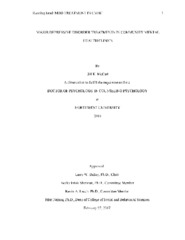Major Depressive Disorder Treatments in Community Mental Health Clinics
Abstract
Depression affects many individuals worldwide, indiscriminant of race, gender or age (Burnett-Zeigler, Zivin, Islam, & Ilgen, 2012; Cuijpers & Schoevers, 2004; Watters, 2010). In 2012, the World Health Organization (WHO) estimated that over 350 million people suffer from depressive symptoms worldwide. This statistic is alarming as people who are diagnosed with major depressive disorder not only suffer from the debilitating symptoms associated with major depression, but also have increased rates of death due to suicide (Cuijpers & Schoevers, 2004). Depressive disorders have been found to be associated with increased impairment in role functioning, poorer quality of life, mortality due to physical illness, and suicide (Burnett-Zeigler et al., 2012). Therefore, it is crucial that community mental health providers address the increase in mortality rates. This study focused on the efficacy and survival rates involving two treatment groups in a community mental health setting. The treatment groups consisted of two groups; one group of clients received psychotherapy treatment alone and the second group received combined treatments of pharmacology and psychotherapy. Both treatment groups were similar as all clients were diagnosed with major depressive disorder, received Medicaid benefits for underserved populations, and voluntarily attended treatment services. Psychological wellness was determined by using the Patient Health Questionnaire-9 (PHQ-9) at initial assessment and after six months of treatment. This study also tracked dropout rates between the two different treatment groups to determine if there was a difference in compliance rates between groups.
Original item type
PDF
Original extent
65 pages
Collections
Copyright
This original work is protected by copyright. Copyright is retained by the author(s). Works may be viewed, downloaded, or printed, but not reproduced or distributed without author(s) permission.


 Maintained by the Northwest University Library
Maintained by the Northwest University Library